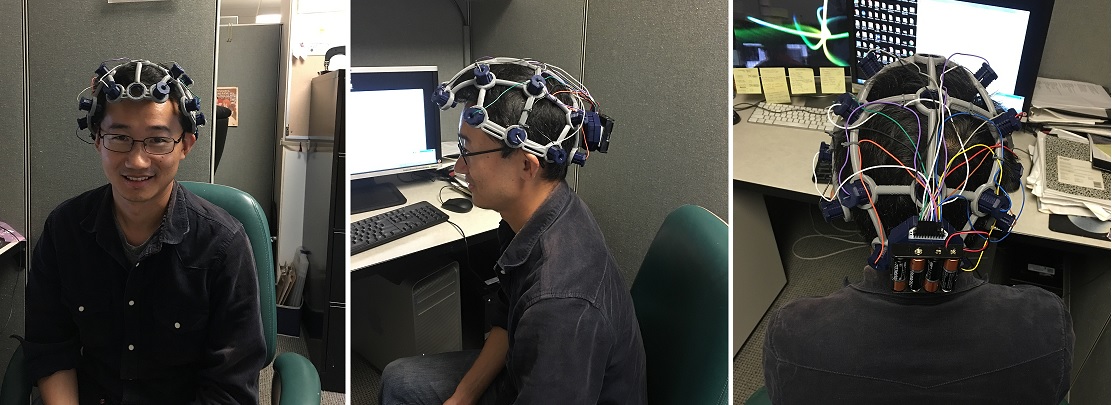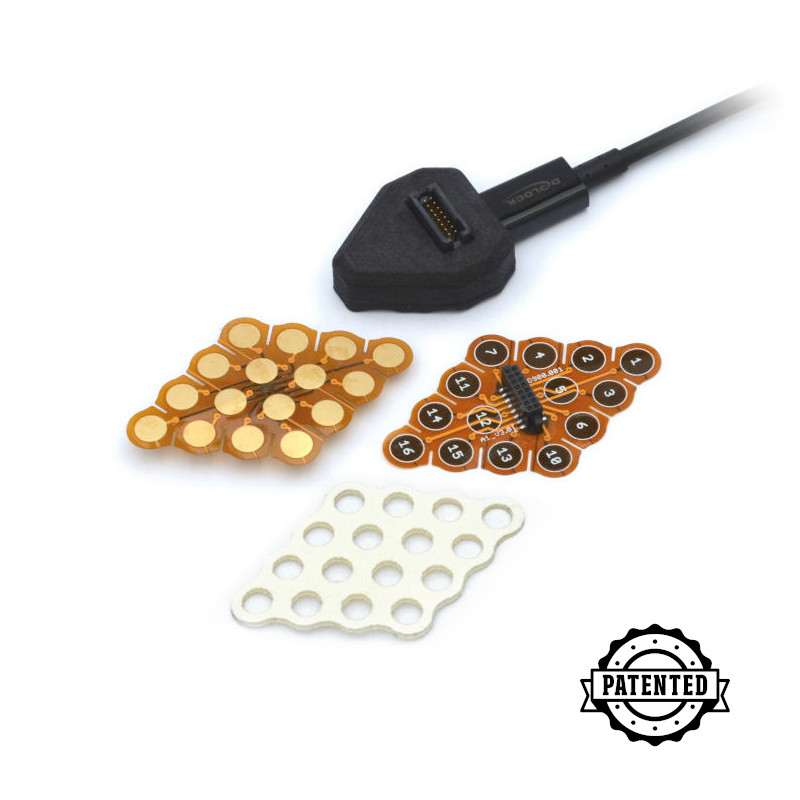Introduction - Current Technologies
Brain-Computer Interfaces (BCIs) are an emerging technology that allows users to interact with computers or other devices using only their thoughts. They have the potential to revolutionize the way we interact with technology and could lead to new applications in fields such as medicine, entertainment, and education. In recent years, there has been a growing interest in non-invasive BCIs that can be used in everyday life. Here we will discuss some of the commercially available non-invasive BCIs and their pros and cons.
- Unicorn Hybrid Black: The Unicorn Hybrid Black is a non-invasive BCI that uses electroencephalography (EEG) to record brain signals. It has 8 hybrid electrodes that can be placed on the scalp, and it uses Bluetooth via a dongle to connect to a computer. The electrodes are placed accordingly to 10-20 international system and need to be fixed on a cap that goes around the head. The Unicorn Hybrid Black has a sampling rate of 250Hz and an 24-bit analog-to-digital converter (ADC). One of the pros of this BCI is that it is easier to set up compared to other EEG, and it has a low latency, which makes it suitable for real-time applications. However, the quality of the signal can be affected by hair or other factors that interfere with the electrode contact with the scalp. It can connect only with the dongle via bluetooth. The electrodes are in a fixed position determined by the cap so there is not so much of a choice for the placement of electrodes and the cap is really visible. The setup time is faster compared to other EEG but it could still take several minutes for beginners and a few minutes for more advanced users. This BCI only uses EEG.

- OpenBCI: OpenBCI is an open-source non-invasive BCI that uses EEG to record brain signals. It has several electrode placement options, such as the 10-20 system or the 10-10 system, and it can use 4 or 8 wet and dry electrodes. The OpenBCI has a sampling rate of up to 250Hz and uses a 24-bit ADC. One of the pros of this BCI is that it is open-source, which means that users can modify or improve the software or hardware. However, the setup process can be more complicated than other BCIs, and it may require some technical expertise. This board can record many different biosignals as long as you can connect them to their pins. The connectivity is also through a dongle via bluetooth. It is possible to buy extensions to reach 16 electrodes and to transmit data via Wi-Fi thanks to a ESP32 microcontroller. This board has a microSD slot to record data in real time locally. That slot might be the cause the sampling rate is 250Hz since the ADC can sample data up to 16kHz. It is nice the cap can be 3D printed but it is still very much visible and set up time still requires several minutes.

- PiEEG: PiEEG is a shield for raspberry pi 4 that can record 4 or 8 biosignals through pins. The electrodes that can be placed on the scalp using a cap. The PiEEG has a sampling rate of 16kHz and uses a 24-bit ADC. One of the pros of this BCI is that it is relatively low-cost and can be used for basic EEG experiments. This shield can only be used with a Raspberry Pi4. It is completely open-source, even the PCB design.

- HackEEG: HackEEG is an open-source shield for Arduino. It works in a similar way as PiEEG and has the same specifications as well. One of the pros of this BCI is that it is open-source and the same advantages of PiEEG as well the same disadvantages.

New Strategy
Only Unicorn Hybrid Black has fixed electrodes. The other three devices can swap electrodes and use them in many different ways and even different applications. The major problem seems that in order to stick the electrodes on the scalp and to make sure they don’t move, they use caps that are very visible and have fixed positions for the electrodes. Also, the set up time can be consuming. This can be fixed by using a different kind of electrode. All of them rely either on gel, dry, or hybrid electrodes which require some kind of support for continuous and stable contact. The ideal electrode would be reusable and adhesive so it will not require any support and can be used multiple times. At the same time, the signal to noise ratio of the electrode should be high. There has been a huge improvement in using hydrogel as electrodes. The advantages are:
- They are very adhesive and leave no mark on the skin
- The signal to noise ratio is higher than the gold standard Ag/Cl electrodes
- They can be used for a long time and multiple times with only slightly difference in signal
- They don’t require any paste or gel
- They can be placed everywhere easily and fast and this makes them perfect for many different applications.

The main disadvantage is that in order to make them you require an UV and vacuum chamber. This means not everybody can make these electrodes but I am not sure if other electrodes are easier to make or require more complicated instruments. The hydrogel will allow me to design a BCI that is more invisible and fits for everyday use while having a higher signal to noise ratio and the freedom to place the electrodes wherever I want.
I am designing the PCB to include the same ADC that the other BCI and shields use. I want to use an ESP32 so I don’t need a dongle to connect with the raspberry pi 4 and I have more freedom to connect either with bluetooth or wifi. For the moment, I can use an ESP32 feather board to test the connectivity of the ESP32 to the raspberry pi 4. This would be a prototype of a prototype. I can make the hydrogel in the lab and test it as an electrode. Since I have a tensile machine, I can test the mechanical properties of the hydrogel and see if I get the same ones as I found on the internet. Something I want to test is to make the hydrogel as small as possible. The g.tech has a technology called g.PANGOLIN which provides ultra-high-density EEG. This technology allows for easier decoding of fingers and can cover the entire head with 1024 electrodes. Of course, the entire setup costs tens of thousands of euros. I want to test if I make the hydrogel with a diameter of 5.9mm (the same as g.PANGOLIN) so I can have the same technology but for only a few euros. The main differences would be that g.PANGOLIN is not a portable device and really visible but can collect data at 38.4 kHz. I don’t have data on signal to noise ratio, but I will compare the impedance of the electrodes. Everything else seems really similar since both set up allows for freedom of placement and adhesive. Keep in mind, the two setups use different technologies. I am not sure for the g.PANGOLIN if the electrodes are reusable or if you need a paste for adhesion and signal. For the next post, I will connect my ESP32 feather board to the raspberry pi 4 and transmit some data using the hydrogel electrodes. I hope in the end I will post my design of the BCI but I am working to get a patent on it. I will update you on that as well.

Conclusion
In conclusion, there are several commercially available non-invasive BCIs that can be used for everyday stuff, each with its pros and cons. The choice of BCI will depend on the user's needs, budget, and technical expertise. It is important to note that the quality of the signal can be affected by several factors, such as electrode placement and interference, and that the results may vary depending on the user. Nevertheless, non-invasive BCIs have the potential to open new horizons in the field of human-computer interaction and neuroscience research. My goal is to develop a full BCI system that can compare with more expensive BCI available on the market while it can provide the same or higher data resolution for everyday use and being mostly invisible. Of course, everything must be easy to use for everybody.


-

Thern1955
-
Cancel
-
Vote Up
0
Vote Down
-
-
Sign in to reply
-
More
-
Cancel
Comment-

Thern1955
-
Cancel
-
Vote Up
0
Vote Down
-
-
Sign in to reply
-
More
-
Cancel
Children